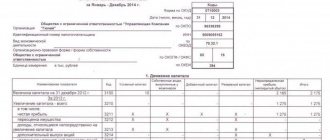The essence of the company's net assets and authorized capital
According to clause 4 of the order of the Ministry of Finance of the Russian Federation “On approval of the Procedure for determining the value of net assets” dated August 28, 2014 No. 84n, net assets (NA) mean the difference between assets and liabilities.
Assets do not include debt on contributions of participants to the authorized capital (AC), and liabilities do not include deferred income when accepting government assistance or receiving free property. Also, assets or liabilities displayed on off-balance sheet accounts are not used in establishing the value of the NA. When calculating the size of the NAV, the difference between assets and liabilities shows what funds the company will have if it pays off absolutely all obligations in relation to third parties. The greater the value of the NAV, the higher the level of financial stability of the company, since it conducts its activities mainly at the expense of its own funds rather than those of other people.
For detailed information, see the material “What are net assets and how to calculate them?” .
The authorized capital of an organization is the funds transferred by the founders of the company in the form of property, securities, property rights, cash, etc. For each organizational and legal form of an economic entity, there is a minimum size of the charter capital, fixed at the legislative level. The specific size of the capital is reflected in the constituent documentation when creating and registering a business entity.
We talked about the authorized capital of LLC here.
How to increase the value of assets
In order to increase the value of a company's net assets, it is necessary to take one of the following actions.
- Revaluation of existing assets, namely fixed assets and intangible assets. The point is that, as a result of the revaluation, the value of assets may increase and thus bring the net asset indicator out of the minus. After this procedure is carried out in accounting, the entire revaluation is reflected in the account. 83, thereby increasing additional capital, which, in turn, will affect the size of net assets.
IT SHOULD BE NOTED! When deciding to revaluate assets, an organization will have to carry it out on an ongoing basis, since isolated cases of such actions may be negatively assessed by regulatory authorities, who may subsequently impose sanctions on the company in accordance with the Tax Code of the Russian Federation and the Code of Administrative Offenses of the Russian Federation.
- Increasing assets by replenishing a current account with cash or adding additional property for the company to conduct its activities. In accounting, actions for depositing funds are reflected in other income (account 91), and for depositing property - in deferred income (account 98).
Why should net assets be greater than authorized capital?
In business, to talk about a company's good financial position, its net assets must be greater than its authorized capital. This is an indication that the company not only did not spend the initial funds transferred to it as contributions to the authorized capital, but was also able to increase them.
A situation where net assets are less than the authorized capital can only occur at the very beginning of the operation of an enterprise. Subsequently, with the effective development of activities, the accumulated own funds should be greater than those contributed by the founders, and then the company will be considered investment-attractive and reliable.
How to correctly calculate the amount of net assets on the balance sheet, read the article “The procedure for calculating net assets on the balance sheet - formula 2020-2021.”
Consequences for LLCs and JSCs when the asset value is less than the capital amount
According to Art. 30 of the Law “On Limited Liability Companies” dated 02/08/1998 No. 14-FZ, if after the financial year it turns out that the net assets of the LLC are less than the authorized capital, the company is obliged to either reduce the authorized capital or carry out a liquidation procedure. In this case, the analyzed year must be the third or subsequent year after the years in which such a situation was observed. The decision to hold an event is made within 6 months after the end of the current year.
The same decision is approved in relation to joint stock companies, as indicated in paragraph 6 of Art. 35 of the Law “On Joint Stock Companies” dated December 26, 1995 No. 208-FZ. In addition, according to paragraph 7 of Art. 35 of this law, if during the analyzed year (according to reporting for 3, 6 and 9 months) a similar situation is observed, the joint-stock company must publish a notice in the media about a decrease in the value of the asset price.
The liquidation of organizations that have had less than their capital assets for 2 years or more is carried out forcibly, as indicated in clause 11 of Art. 7 of the Law “On Tax Authorities” dated March 21, 1991 No. 943-I. In accordance with this regulatory act, tax authorities have the right to put forward legal claims for the liquidation of an enterprise of any form of business on legally established grounds.
IMPORTANT! In the annual report of the LLC, be sure to include a section on the status of the private equity. To do this, please provide information on the dynamics of changes in the size of the net asset value for the last 3 completed financial years, as well as their comparison with the capital account. If the size of the NA is less than the authorized capital, it is necessary to indicate the reasons and factors that led to this situation, and a list of measures to correct it.
If the value of net assets at the end of 2022 is lower than the size of the authorized capital, then the consequences will be less painful. These changes are related to the spread of coronavirus and came into force on April 7, 2022 (Federal Law No. 115-FZ dated 04/07/2020).
Attention! Warning from ConsultantPlus: Reduction in the value of the net assets of JSCs and LLCs If the value of the company’s net assets at the end of 2022 is lower than the size of its authorized capital, you will not have to: ... For all details, see K+.
Estimate net assets
“Net assets” is not just a term from economic theory. By calculating this indicator, you can assess the “health” of the company, learn about its financial stability, and justify the possibility of paying dividends. And sometimes the very existence of a company depends on the size of its net assets.
L. Izotova The net assets of a company are actually its own capital.
That is, assets free from all debt obligations. So the more of them, the more efficient the company’s work. Joint-stock companies (closed and open) and limited liability companies are required to monitor the amount of net assets. After all, if this indicator becomes less than the authorized capital, then the “charter” will have to be reduced, and the payment of dividends can be forgotten for a while (Articles 35, 43 of the Law of December 26, 1995 No. 208-FZ “On Joint-Stock Companies”, Art. 20, 29 of the Law of February 8, 1998 No. 14-FZ “On Limited Liability Companies”). Those companies whose authorized capital, as a result of recalculation, turns out to be less than the permissible minimum (currently for LLCs and CJSCs - 10,000 rubles, for OJSCs - 100,000 rubles) will have to be liquidated.
This requirement of legislators is quite understandable. After all, entrepreneurial activity should be aimed at “systematic receipt of profit” (Clause 1, Article 2 of the Civil Code). Therefore, over time, the company's equity capital should grow. And if it decreases, moreover, it becomes less than the initially invested funds, then this means the financial instability of the society. The disappointing conclusion can be drawn that the company spends more than it earns.
In such conditions, the owners are obliged to either take urgent measures to correct the situation or liquidate the company. Otherwise, the company may be closed by court decision. Similar situations occur in arbitration practice (resolutions of the FAS East Siberian District dated November 19, 2002 No. A74-4154/01-K2-F02-3401/02-S2, FAS Far Eastern District dated July 25, 2006 No. F03-A73 /06-1/2138). So the net asset indicator is of no small importance and monitoring its dynamics is vital for any company. Let's figure out how to calculate it.
One formula for everyone
Net assets can be easily calculated using data from the balance sheet. To do this, the amount of liabilities is subtracted from the amount of assets. True, not all balance sheet indicators are included in the calculation. Thus, the value of own shares purchased from shareholders and the debt of the founders for contributions to the authorized capital must be excluded from the assets. And the liabilities do not take into account capital and reserves (section III) and deferred income (code 640 of section V). All data should be taken from the company’s latest duly approved balance sheet.
This calculation procedure has been adopted for joint-stock companies (Order of the Ministry of Finance dated January 29, 2003 No. 10n, FCSM No. 03-6/pz). There is no regulatory document for calculating the net assets of limited liability companies. Specialists from the main financial department believe that LLCs can use the rules developed for JSCs (letter of the Ministry of Finance dated January 26, 2007 No. 03-03-06/1/39). The arbitrators adhere to similar conclusions (resolution of the Federal Antimonopoly Service of the Ural District dated April 18, 2006 No. F09-2886/06-S5).
The amount of net assets does not have to be calculated independently. Its meaning can be found in the reference to Form No. 3 “Report on Changes in Capital” (Order of the Ministry of Finance dated July 22, 2003 No. 67n).
Having found out the required figure, all that remains is to compare it with the amount of the authorized capital (code 410, section III of the balance sheet). What if the conclusion is not in favor of the company? Are there any ways to increase your net asset value?
We need to work better
Having carefully studied the procedure for calculating net assets, we can conclude that to solve the problem it is necessary to increase the company’s assets and reduce the indicators of sections IV and V of liabilities, that is, reduce the amount of long-term and short-term liabilities. How to achieve this? For example, by managing accounts receivable and payable, increasing the efficiency of the company, analyzing profitability and pricing policy, and cost planning. However, if a solution is needed immediately, then such “correct” methods will not work. After all, they are designed for the future.
Maybe just take out a loan or credit? No. Unfortunately, borrowing money or a bank loan will not help increase net assets. The fact is that, for example, when accounting for a loan, the accountant makes an entry to the debit of account 51 and the credit of account 66 “Settlements for short-term loans and borrowings.” Thus, both the active and passive parts of the balance will be increased by the amount received. And the amount of net assets will remain the same.
But still, the company has ways to increase its own capital. You can, for example, reassess the value of the company's property, attract additional investments, or merge with another company. Let's look at each of these methods.
We will evaluate the property
Revaluation of fixed assets does not provide real capital growth. It only improves the results “on paper”. A company can revaluate its property once a year. The results must be reflected in the balance sheet at the beginning of the reporting period, that is, on January 1 (clause 15 of PBU 6/01, approved by order of the Ministry of Finance dated March 30, 2001 No. 26n).
According to the accounting rules, the amount of additional assessment of the value of property will be taken into account as the debit of account 01 “Fixed assets” and the credit of account 83 “Additional capital”. But capital indicators are not included in the calculation of net assets. Consequently, their cost will increase, and we will solve the problem.
By the way, the results of the revaluation of fixed assets do not need to be included in income when calculating income tax (clause 1 of Article 257 of the Tax Code).
Let's ask for help
Another possible option for increasing assets is to receive gratuitous assistance. It’s better if the founders or shareholders come to the rescue. After all, such gifts will only be excluded from the base for calculating income tax if the donor owns more than 50 percent of the authorized capital (subclause 11, clause 1, article 251 of the Tax Code). Otherwise, you will have to take into account that the liability balance will increase by 24 percent (income tax rate) of the market assessment of the value of the gratuitous deposit.
So, having received free property, it is reflected in the debit of the asset accounting accounts. For example, 01 “Fixed assets” or 10 “Materials”, or 51 “Current account”. And on the credit of account 98 “Deferred income”, subaccount 2 “Gratuitous receipts”. As you know, “deferred income” is not taken into account when calculating net assets, which means it will not reduce the amount of the increased asset.
We are reorganizing the company
Reorganization is probably the most difficult method suggested above. But sometimes it can be the most effective. For example, when operating a group of companies, merging two companies can result in a significant increase in the size of the active part of the balance sheet. Thereby achieving an improvement in the net asset ratio. Moreover, most likely there will be no tax consequences. After all, during reorganization, “the value of property, property and non-property rights received through succession is not taken into account as income” (clause 3 of Article 251 of the Tax Code). However, we must not forget about obligations. They will also have to be combined. So, before deciding to merge, it is necessary to evaluate not only the assets, but also the accounts payable, loans and credits of the upcoming “ally”.
Hello Guest! Offer from "Clerk"
Online professional retraining “Accountant on the simplified tax system” with a diploma for 250 academic hours . Learn everything new to avoid mistakes. Online training for 2 months, the stream starts on March 15.
Sign up
Reducing the capital as a way to correct the situation
Before a decision is made to terminate activities, a business entity must take measures aimed at correcting the current situation. In accordance with Art. 90 of the Civil Code of the Russian Federation, if the size of net assets is less than the authorized capital, it is necessary to equalize their values, for which the capital can be reduced.
This operation can be carried out only if the new size of the capital is not less than the legal minimum. If the size of the NA is already less than the minimum permissible value of the authorized capital, then it is impossible to equalize their amounts by reducing the size of the authorized capital. In such a situation, the Federal Tax Service may file a lawsuit to liquidate the company. But if an organization pays wages, transfers payments to the budget, settles accounts with counterparties and generally has a good reputation, the courts, as a rule, reject claims regarding liquidation.
Read about the procedure for reducing the authorized capital here.
Ways to increase NA
You don’t have to reduce the MC, but increase the NA. This procedure can be performed using one of 2 methods:
- Carry out a revaluation of intangible assets and fixed assets, and this must be done before the end of the financial year. With this procedure, the initial cost of objects is brought into line with their market value, and in addition, the amount of calculated depreciation is recalculated.
IMPORTANT! This procedure must be carried out in the future. It must be carried out by an independent expert who has no interest in increasing the value of the objects.
- Increase the size of assets by contributing funds or property by the founders to directly increase the NAV. In this case, they will be classified as other income, which will entail an increase in the amount of retained earnings and, ultimately, an increase in the size of the NAV.
ATTENTION! These receipts are not taken into account when determining the taxable base for income tax on the basis of subparagraph. 3.4 clause 1 art. 251 Tax Code of the Russian Federation.
For more information about methods for reducing authorized capital or increasing net assets, read the article “What are the consequences of negative net assets?” .
Results
If the net assets are less than the authorized capital, and this position is held for 2 years or more, a negative event may occur - the tax authorities may file a lawsuit to liquidate the company. To avoid this, you should either reduce the authorized capital or increase net assets.
Sources:
- Tax Code of the Russian Federation
- Order of the Ministry of Finance of the Russian Federation “On approval of the Procedure for determining the value of net assets” dated August 28, 2014 No. 84n
- Law “On Limited Liability Companies” dated 02/08/1998 No. 14-FZ
- Law “On Joint Stock Companies” dated December 26, 1995 No. 208-FZ
- Law “On Tax Authorities” dated March 21, 1991 No. 943-I
You can find more complete information on the topic in ConsultantPlus. Free trial access to the system for 2 days.
Ways to reduce authorized capital
In a joint stock company, according to paragraph.
2 p. 1 art. 29 of the Law on JSC, the reduction of the authorized capital is carried out by reducing the par value of the shares (without paying cash to shareholders or transferring issue-grade securities to them). At the same time, the total number of outstanding shares does not change.
In a limited liability company, the reduction of the authorized capital is carried out by reducing the nominal value of the shares of all participants in the company in the authorized capital of the company.
At the same time, the reduction of the authorized capital of the company by reducing the nominal value of the shares of all participants in the company must be carried out while maintaining the size of the shares of all participants in the company (Clause 1, Article 20 of the LLC Law).






